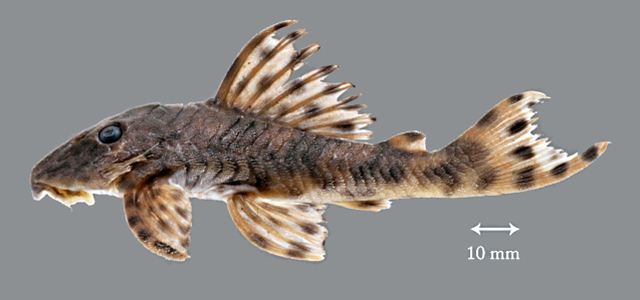| Loricariidae (Armored catfishes), subfamily: Hypostominae |
| 8.34 cm SL (male/unsexed) |
|
demersal; freshwater; pH range: 6.1 - 6.2 |
| South America: Oyapock River in French Guiana. |
|
Dorsal spines (total): 2-2; Dorsal soft rays (total): 7-7; Anal spines: 1-1; Anal soft rays: 5-5. It is distinguished from other Guianese species by its specific barcode sequences (JF747001- JF747002) and from all congeners except Peckoltia oligospila, P. bachi,
P. sabaji, P. otali and P. capitulata by having a spotted pattern of coloration of body including posterior part. It differs from the latter by teeth shape, with both lobes similar, long (unless if worn), lateral lobe being only very slightly smaller than medial lobe (vs. distinctly smaller). It can be diagnosed further from spotted species by having a longer hypertrophied cheek odontodes, longest one passing posterior end of cleithrum (vs. not reaching). It can be further separated from Peckoltia bachi and P. otali by rounded spotting (vs. mottling), from P. sabaji by smaller spots on caudal peduncle, and from P. capitulata by presence of spots on head (vs. absence). It differs further from P. oligospila by having a smaller body depth (19.8- 20.4% SL vs. 21.1-23.4), narrower body (29.5-30.7% SL vs. 30.9-32.8) and shorter orbital diameter (5.9-7.0% SL vs. 6.9-8.1) (Ref. 90183). |
| Found in small forest creek tributaries on sandy and graveled bottom with rocks, woods and leaves (Ref. 90183). Collected with other species such as of Ancistrus cf. leucostictus, Ancistrus. aff. temminckii, Guyanancistrus longispinis, Farlowella reticulata, Rineloricaria stewarti, and Otocinclus mariae (Ref. 90183). |
|
Endangered (EN); Date assessed: 14 January 2021 (B1ab(iii)+2ab(iii)) Ref. (130435)
|
| harmless |
Source and more info: www.fishbase.org. For personal, classroom, and other internal use only. Not for publication.
